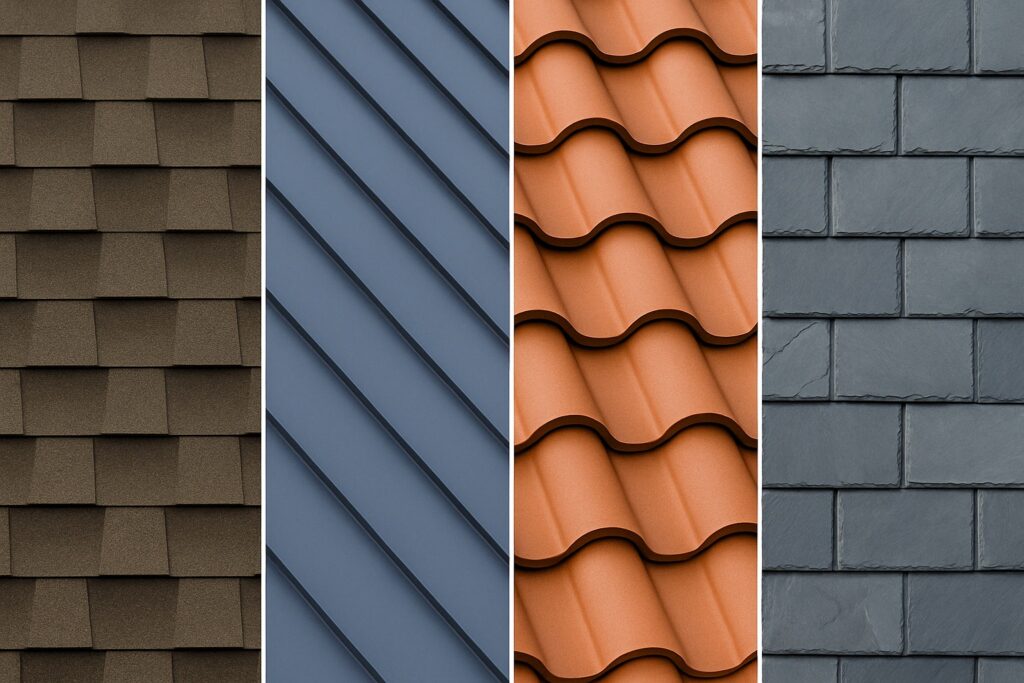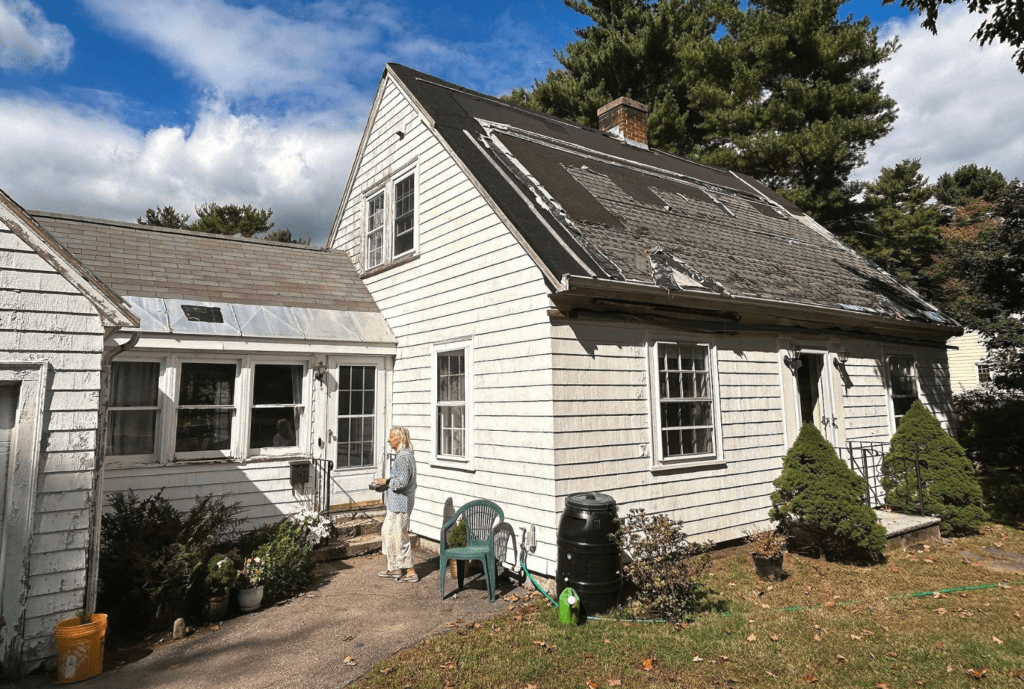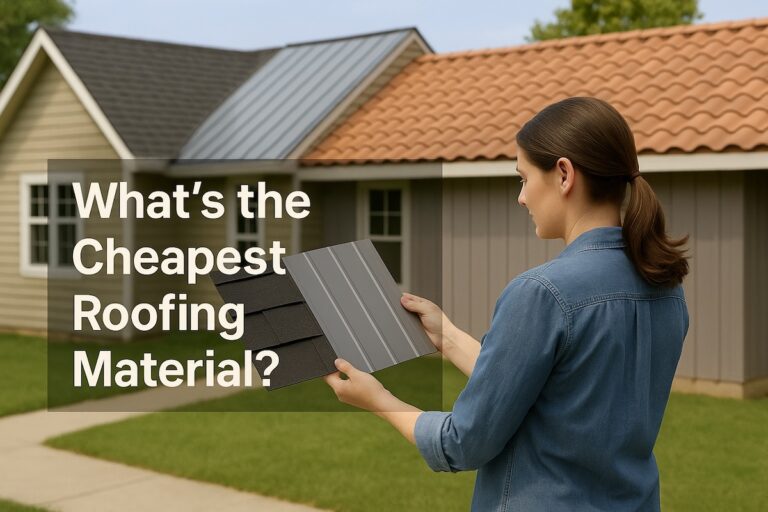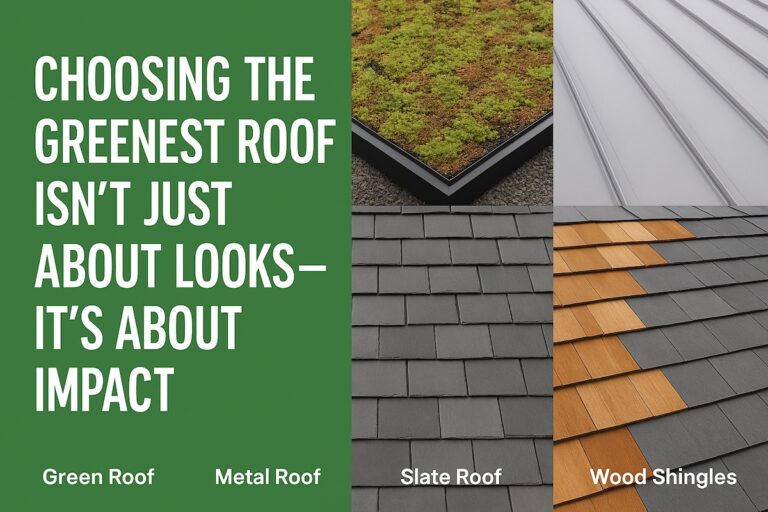-
-
Asphalt shingles remain the most popular roofing material for a reason: affordable, easy to install, and reliable for 20–30 years.
-
Metal roofs are a top choice for energy-efficient roofing. They resist fire, wind, and hail—and can last up to 70 years.
-
Clay tile roofs and concrete tile roofs excel in hot climates, offering heat reflection and durability with timeless style.
-
Impact-resistant shingles are ideal in hail-prone or high-wind zones, combining curb appeal with added protection.
-
Slate roofs are the longest-lasting roofing material—luxurious, fireproof, and rated to last 100+ years with proper support.
-
Synthetic roofing materials offer the look of slate or shake at a lower price point and lighter weight.
-
Flat roof systems like TPO, PVC, or EPDM are essential for low-slope designs and require expert installation.
-
Wood shingles and cedar shakes bring natural beauty and insulation but require frequent maintenance in humid regions.
-
Match your roof type to your climate zone—what works in snowy regions won’t survive the heat and vice versa.
💡 Not sure which roof fits your home or budget? Use our Roof Designer Tool to compare roofing materials, styles, and costs in real-time.
-
Introduction
Choosing the right roofing material isn’t just about looks — it’s about durability, energy efficiency, and long-term value. In climates with heavy rain, strong sun, or high winds, the wrong roof can lead to costly repairs and reduced home protection. Whether you’re replacing a worn-out roof or planning a custom build, understanding how different roofing materials perform is essential. This guide compares popular roof types—like asphalt, metal, tile, and slate—by cost, climate compatibility, and maintenance to help you make a smart, future-proof investment.
Choosing the right roof material isn’t just about what looks pretty on Pinterest. It’s the difference between a 15-year headache and a 50-year investment that actually increases your home value. Let’s break down what actually matters when you’re staring at those roofing samples.

The Personality Test: Matching Roof Types to Your Home
Every roof material has a personality. No, I’m not losing it — hear me out. Think of asphalt shingles as your reliable friend who’s always on time but rarely surprises you. Metal roofs? They’re the eco-conscious marathon runners of the bunch — they’ll cost more upfront but outlast nearly everything else. Understanding these “personalities” helps match the right type of roof to your specific situation.
Climate: Your Roof’s Biggest Frenemy
I once had a client in Colorado insist on clay tile because she loved the Mediterranean look. What she didn’t love? The $15K repair bill after our first serious winter. Here’s what actually works where:
- Heavy rain regions: Stand seam metal roofs are your BFF. The raised seams keep water flowing and minimize leakage points.
- Hail alley states: Impact-resistant asphalt shingles or metal with specialized coatings. Standard slate will crack under serious hail.
- High wind areas: Properly installed metal roof systems or architectural shingles rated for 130+ mph winds.
- Hot, sunny climates: Clay tile roof options reflect heat beautifully, while dark asphalt will cook your attic.
- Snow-heavy regions: Metal roofs that shed snow or reinforced structural systems for slate‘s heavy weight.
Budget Reality Check
Let’s talk money — because that gorgeous slate roof might cost 5x what asphalt shingles run. Here’s what I tell my clients:
Budget Tier ($-$$):
- Asphalt shingle roof: $4-6 per square foot installed
- Roll roofing: $2-4 per square foot for flat roof applications
- Basic metal roof panels: $7-10 per square foot
Mid-Range ($$-$$$):
- Wood shingles or cedar: $8-14 per square foot (plus regular maintenance)
- Stand seam metal: $10-16 per square foot
- Synthetic slate: $8-12 per square foot
Premium ($$$-$$$$):
- Authentic slate roof: $15-30+ per square foot
- Clay tile or concrete tile roof: $12-25 per square foot
- Solar shingles: $20-35 per square foot (but energy savings offset costs)
My rule of thumb: Whatever you budget, add 15% for surprises. I’ve never seen a roof replacement come in under budget when the decking needed work.
The Material Showdown: What You’re Really Buying
Asphalt Shingles: The Crowd Pleaser
Over 75% of American homes have asphalt shingle roofs, and there’s a reason — they’re the Honda Civic of roofing. Reliable, relatively affordable, and they get the job done.
The good stuff:
- Most affordable complete roof system for most homeowners
- Widely available (your roofer won’t have 8-week backorders)
- Decent durability (20-30 years) with minimal maintenance
- Architectural shingles add dimension and wind resistance
The not-so-good:
- Basic 3-tab shingles can look flat and uninspiring
- Granule loss happens over time, especially in harsh sun
- Not the most environmentally friendly option
- Can’t handle extreme heat as well as other materials
Real talk: I put architectural asphalt shingles on my own home five years ago. They’re not sexy, but they’re practical for my budget and climate. The new impact-resistant ones with flexible fiberglass are miles better than what we installed even 10 years ago.
Metal Roofing: The Marathoner
Metal roofs aren’t just for barns anymore. The modern metal roof offers incredible longevity and surprising style versatility.
Types that matter:
- Stand seam metal: The premium option with hidden fasteners and clean lines
- Exposed fastener panels: More affordable but more maintenance over time
- Metal shingles: Looks like traditional materials but performs like metal
Why I’m installing more than ever:
- 40-70 year lifespan (I have clients who’ll never replace their roof again)
- Highly resistant to wind, fire, and rot
- Energy efficient (can reduce cooling costs by 15-25%)
- Recyclable when it eventually needs replacement
Downsides nobody mentions:
- Rain sounds lovely… until you’re on a Zoom call during a thunderstorm
- Denting from hail is real (though some have impact resistance)
- Installation requires specialized skills (don’t cheap out on your contractor)
Reality check: Metal costs more upfront (about 2-3x asphalt), but amortized over its lifespan, it’s actually cheaper per year. Worth it if you’re staying put.
Slate: The Crown Jewel
Nothing—and I mean nothing—looks as timeless as slate. It’s the Rolex of roofing materials, and it performs like one too.
The luxury experience:
- Genuinely lasts 75-100+ years (there are 200-year-old slate roofs still performing)
- Incredible curb appeal and distinctiveness
- Completely fireproof and resistant to rot, mold, and insects
- Environmentally friendly (it’s literally stone)
The reality check:
- Extremely heavy (your structure needs to support it)
- Prohibitively expensive for many budgets ($15-30+ per square foot)
- Difficult to find qualified installers in many regions
- Can crack under impact from falling branches or serious hail
Synthetic slate alternatives: If you’ve got champagne taste but a prosecco budget, synthetic slate options have improved dramatically. They deliver the look at about half the price and weight. The durability isn’t comparable (40-50 years vs. 100+), but still solid.
Clay Tile & Concrete Tile: The Mediterraneans
That Spanish or Mediterranean look requires clay tile or its more affordable cousin, concrete tile. These materials excel in hot, sunny climates.
Clay tile benefits:
- Lasts 50-100+ years with minimal maintenance
- Doesn’t rot or burn, and bugs don’t eat it
- Excellent thermal properties (keeps homes cooler)
- Distinctive aesthetic that defines certain architectural styles
Concrete tile advantages:
- More affordable than clay while mimicking the appearance
- Can be manufactured to resemble slate, wood, or traditional clay
- Extremely durable against the elements
- Color-through options won’t show wear as dramatically
Shared challenges:
- Heavy materials requiring adequate structural support
- Can crack under impact or when walked on incorrectly
- Installation is specialized and labor-intensive
- Not ideal for regions with freeze-thaw cycles
Expert tip: If you love the tile look but worry about weight, check out lightweight concrete tile options. They’re about half the weight of traditional concrete tiles while maintaining the aesthetic.
Wood Shingles & Cedar: The Naturalists
There’s something authentically beautiful about a cedar shake roof weathering to a silvery gray. Wood roofing brings warmth and character that manufactured materials can’t quite match.
The natural appeal:
- Unique character that develops a gorgeous patina over time
- Excellent insulation properties (better than asphalt)
- Can last 30-40 years with proper maintenance
- Biodegradable and sustainable if properly sourced
Maintenance realities:
- Requires regular cleaning, treatment, and inspection
- Vulnerable to mold, moss, and rot in humid climates
- Fire concerns (though treatments can improve fire resistance)
- Increasingly expensive as quality cedar becomes scarcer
From my files: I helped a client restore a 1920s craftsman with a cedar roof last year. The material cost alone was 3x what it would have been five years ago, but nothing else would have maintained the home’s historical integrity.
Flat Roof Specialties
If you’ve got a flat or low-slope section, your options narrow considerably. Standard pitched roof materials won’t work here.
Modern flat roof contenders:
- TPO or PVC membranes (the white roofs you see on commercial buildings)
- EPDM rubber roofing (the black, rubber-like material)
- Modified bitumen or roll roofing for budget applications
- Green roof systems for the environmentally conscious with structural capacity
The flat roof truth: These aren’t DIY-friendly installations. The seams and flashing details make or break waterproofing, and failures are expensive. Always hire specialists for flat roof sections.


ROOFING VISUALIZER TOOL
See Your Home with a New Roof in Seconds
Help your homeowners visualize new roofing and colors on their own home with Renoworks’ AI technology in seconds.
- Easy-to-use interface designed for contractors and professionals working with homeowners.
The New Kids on the Block
Solar Shingles: Roof + Power Plant
Tesla isn’t the only player anymore. Solar shingles integrate energy production directly into your roof material instead of mounting panels on top.
Current reality:
- Still 2-3x the cost of premium conventional roofing
- Technology improving rapidly (efficiency is up 40% in five years)
- Aesthetically superior to bolt-on solar panels
- Payback periods of 10-15 years depending on local utility rates
My prediction: Within 5 years, we’ll see solar roofing hit price parity with premium materials like slate when you factor in energy production. Not quite there yet for most homeowners.
Green Roofs: Living Coverage
Particularly in urban areas, green roof systems are gaining traction. These living roofs replace traditional materials with vegetation over a waterproof membrane.
Benefits beyond aesthetics:
- Exceptional insulation properties
- Stormwater management (absorbs rather than sheds rainwater)
- Reduces urban heat island effect
- Creates habitat for birds and insects
Implementation challenges:
- Significantly heavier than conventional roofing
- Higher initial installation cost
- Requires specialized maintenance (it’s literally gardening)
- Not suitable for steeply pitched roofs
Making Your Final Decision
After helping hundreds of homeowners choose their roof material, here’s my framework:
- Be honest about your timeline. Planning to sell in 5 years? Asphalt makes financial sense. Staying forever? Premium materials start looking better.
- Respect your climate. The best roof for your home depends more on your weather than your taste. No material excels everywhere.
- Balance initial cost with longevity. Divide the material cost by expected years of service to get your annual cost of ownership.
- Consider your home’s structural capacity. Some materials simply weigh too much for certain homes without expensive reinforcement.
- Don’t forget maintenance. Low maintenance isn’t no maintenance. Budget for what your roof material actually requires.
Finding the right roof contractor is as important as choosing the right material. Get at least three quotes, check references obsessively, and never—I repeat, never—choose solely on price. I’ve cleaned up too many messes from the “lowest bidder.”
Frequently Asked Questions
What is the most cost-effective roofing material?
Asphalt shingles remain the most budget-friendly option, costing around $4–$6 per square foot installed. They’re widely available, easy to install, and ideal for homeowners seeking an affordable, dependable solution.
What is the longest-lasting roof type?
Slate roofing can last 75–100+ years when installed properly. It’s the most durable roofing material available, offering excellent resistance to fire, moisture, and decay—but at a premium cost and weight.
Is a metal roof worth the higher cost?
Yes. While a metal roof costs 2–3x more than asphalt initially, it can last 40–70 years, reduce energy costs, and resist high winds, hail, and fire. Over its lifetime, it offers a lower cost per year of service.
Which roofing material is best for hot climates?
Clay tile roofing and cool roof technologies like light-colored metal reflect heat effectively and keep interiors cooler. In sun-heavy regions, these options reduce strain on HVAC systems.
What type of roof is best for snow and heavy rain?
Metal roofing systems with steep slopes help shed snow efficiently. Standing seam metal roofs and impact-resistant shingles also excel in wet, windy conditions by minimizing leaks and structural strain.
Are solar shingles a good alternative to traditional roofing?
Solar shingles combine roof protection with energy generation, making them ideal for eco-conscious homeowners. Though the upfront cost is higher, utility savings may offset the investment over time.
How do I know if my roof can support heavy materials like slate or tile?
Weight is a critical factor. Your roof’s structural capacity must be assessed by a qualified contractor or engineer before installing slate tiles, concrete tile roofing, or green roof systems.
What’s the difference between architectural shingles and 3-tab shingles?
Architectural asphalt shingles offer better durability, thicker composition, and improved wind resistance compared to basic 3-tab shingles. They also enhance curb appeal with a dimensional look.
How often should a roof be replaced?
It depends on the material:
-
Asphalt shingles: 20–30 years
-
Metal roofs: 40–70 years
-
Slate or tile: 50–100+ years
-
Wood shingles: 30–40 years with proper maintenance
How do I choose the right roof for my region?
Match material performance to local climate:
-
Hot & sunny: Clay tile, cool metal roofs
-
Rainy or coastal: Standing seam metal
-
Snow-heavy: Metal, reinforced slate
-
High wind zones: Architectural shingles or metal rated for 130+ mph


ROOFING VISUALIZER TOOL
See Your Home with a New Roof in Seconds
Help your homeowners visualize new roofing and colors on their own home with Renoworks’ AI technology in seconds.
- Easy-to-use interface designed for contractors and professionals working with homeowners.
Related Articles
Continue exploring this topic with these related articles, or read one of our case studies to see how visualization has helped remodelers save time and increase their profits.



